If you’re a birder, you know that geese are among the most interesting and enjoyable birds to watch.
In Wyoming, we’re lucky enough to have a large population of geese, which can be seen in many different locations throughout the state.
Whether you’re watching them fly overhead or swimming in a river or lake, these birds are sure to delight and fascinate.
What Geese Are in Wyoming?
There are six types of geese in the state of Wyoming.
- Canada Goose
- Snow Goose
- Ross’s Goose
- Cackling Goose
- Greater White-Fronted Goose
- Brant
There are also two types of swans in Wyoming – Trumpeter Swans and Tundra Swans.

Canada Goose


Canada Goose Sound
Scientific Name: Branta canadensis
Length: 30 to 43 in
Wingspan: 50–73 in
Weight: 5.7–14.3 lb
The Canada Goose is a large, well-known species of waterfowl noted for its distinctive appearance, familiar “honk,” and migratory behavior.
Appearance: Both male and female Canada Geese have a similar appearance, featuring a black head and neck with distinctive white patches on the cheeks and chin. The body is primarily brown with a lighter, often white, underbelly.
Diet: Canada Geese primarily feed on plant matter, including grasses, aquatic vegetation, and grains. They can often be seen grazing in parks, lawns, and fields, as well as dabbling in water bodies.
Reproduction: Canada Geese typically nest on the ground near water bodies, often on islands or other isolated areas to avoid predators. The female lays a clutch of about 4 to 6 eggs, which she incubates alone for around a month.
Snow Goose

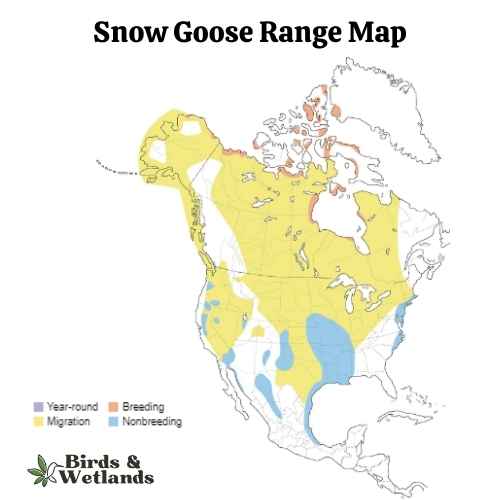
Snow Goose Sound
Scientific Name: Anser caerulescens
Length: 25 to 31 in
Wingspan: 53 to 65 in
Weight: 4.5 to 6.0
The Snow Goose is a large species of waterfowl known for its vibrant white plumage and significant migratory flights.
Appearance: True to their name, Snow Geese are predominantly white with black wingtips. They also have a pink bill, pink legs and feet. A color morph, known as the “Blue Goose,” displays a bluish-gray body with a white head, but is considered the same species.
Diet: Snow Geese primarily feed on plant matter, such as grasses, sedges, and small grains. They can often be seen in large flocks foraging in fields and marshes, and during migration and winter, they can cause considerable damage to agricultural fields due to their feeding habits.
Reproduction: Snow Geese typically nest on the tundra, near water bodies. The female builds the nest and lays a clutch of about 3 to 5 eggs, which she incubates alone for approximately three weeks. Once hatched, the goslings can feed themselves but stay with their parents for protection until they can fly.
Ross’s Goose
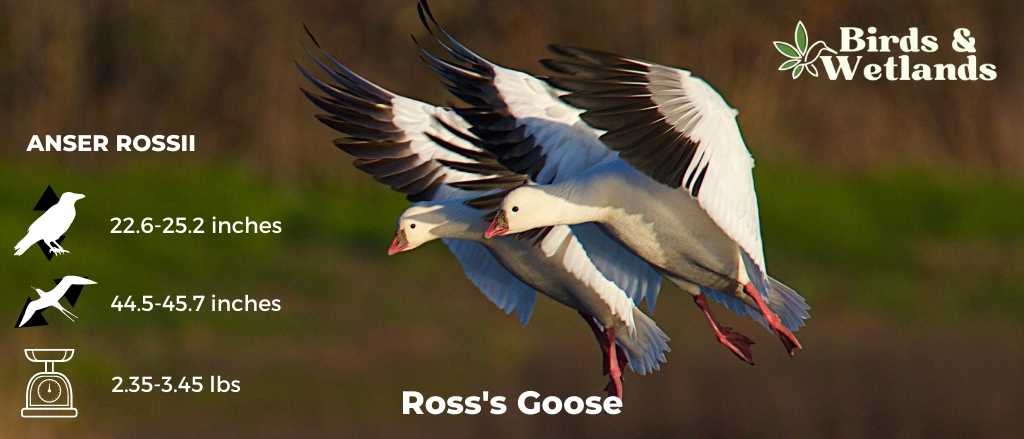
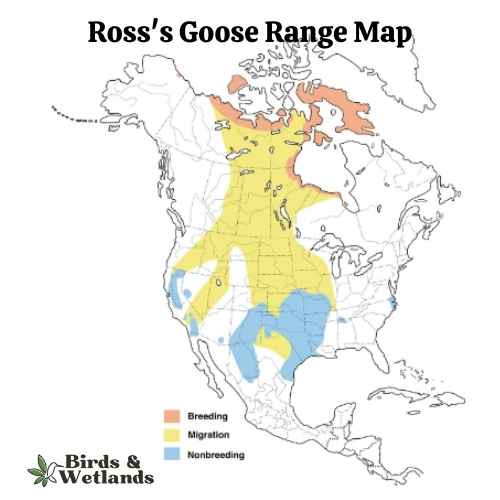
Listen
Scientific Name: Anser rossii
Length: 23.2-25.2
Wingspan: 44.5-45.7 in
Weight:42.3-55.3 oz
The Ross’s Goose is a small species of waterfowl often found in North America’s tundra and wetland habitats.
Appearance: Known for its compact size, the Ross’s Goose is mostly white with black wingtips. It features a short, stubby bill and a rounded head. One key identifying feature is the blueish gray base of its bill, which has a warty structure during the breeding season.
Diet: This goose feeds mainly on vegetation, including seeds, leaves, and roots of grasses and sedges. During winter and migration, they also consume grains and seeds from agricultural fields.
Reproduction: The Ross’s Goose nests on the ground, often in colonies. The female lays a clutch of 2 to 5 eggs which she incubates for around three weeks. The young geese, known as goslings, are precocial – they can walk, swim, and feed themselves shortly after hatching, although they stay with their parents until they learn to fly.
Cackling Goose
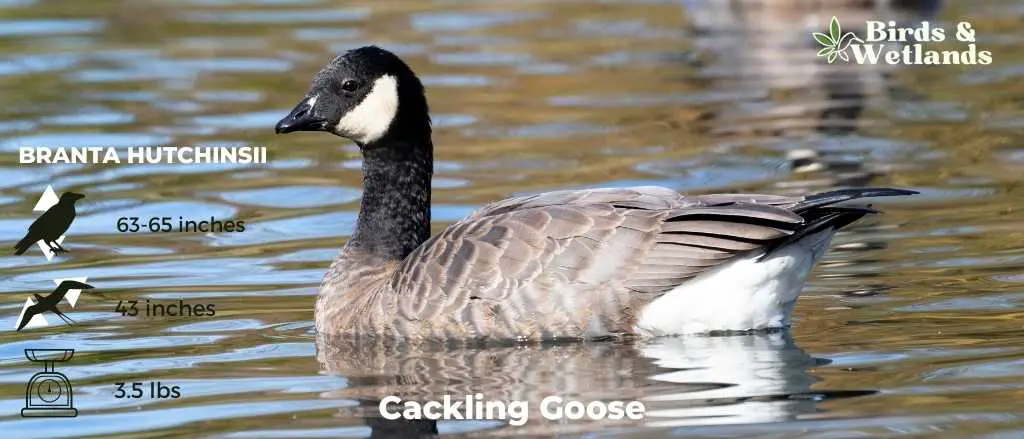
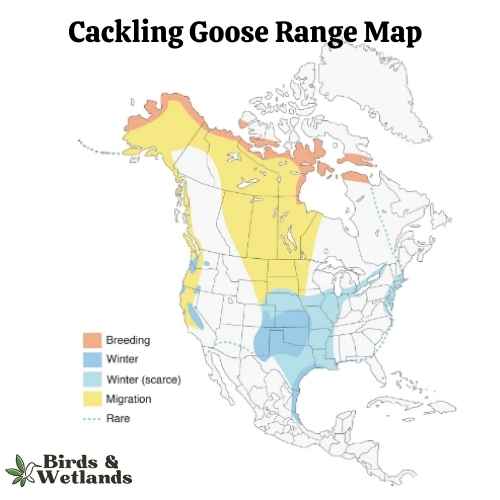
Listen
Scientific Name: Branta hutchinsii
Length: 24.8–25.6 in
Wingspan: 43-45.7 in
Weight:3.5 lbs
Cackling Geese are particularly known for their high-pitched, cackling calls, which is the source of their name. Despite their small size, these geese are renowned long-distance migrants, with some populations traveling thousands of miles between breeding and wintering grounds.
Appearance: With a similar color pattern to the larger Canada Goose, the Cackling Goose features a black head and neck, white chinstrap, light tan to cream chest, and brownish-grey body. One defining characteristic is its noticeably smaller size and stubbier neck compared to its larger counterparts.
Diet: Like many geese, the Cackling Goose’s diet mainly consists of plant matter. This includes grasses, seeds, and aquatic vegetation. They are often seen grazing on land or dabbling in shallow water.
Reproduction: Cackling Geese usually nest on the ground in elevated areas near water bodies, such as riverbanks or lakeshores. The female lays a clutch of 2 to 8 eggs and is responsible for incubation, while the male stands guard nearby. Incubation lasts for about a month.
Greater White-fronted Goose
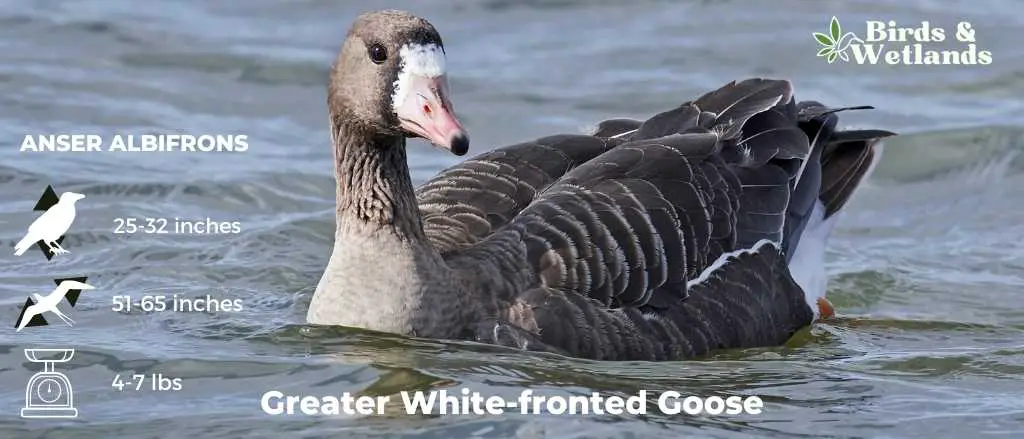

Listen
Scientific Name: Anser albifrons
Length: 25 to 31 in
Wingspan: 53 to 66 in
Weight: 3.3 to 6.6
The Greater White-fronted Goose is a medium to large waterfowl species, widely distributed across the Northern Hemisphere, particularly in North America.
Appearance: As the name suggests, these geese display a prominent white patch at the base of their bill. Their bodies are gray-brown, and their breasts are often marked with dark blotches. They possess a pinkish bill and orange legs and feet.
Diet: The Greater White-fronted Goose is a herbivore and feeds mainly on plant material. Its diet consists of grasses, sedges, grains, and berries. When wintering, these geese can often be found in agricultural fields, feasting on leftover grains and crops.
Reproduction: This species nests on the ground, often in areas with good visibility such as slopes or ridges. The female lays a clutch of 4 to 5 eggs, which she incubates for nearly a month. Once hatched, the young ones are taken care of by both parents until they are able to fly.
Brant

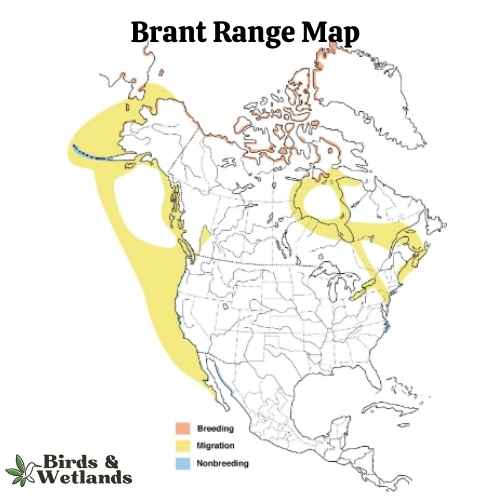
Listen
Scientific Name: Branta bernicla
Length: 22–26 in
Wingspan: 42–48 in
Weight: 1.9–4.9 lb
The Brant is a compact species of goose that is known for its striking appearance and interesting migratory patterns.
Appearance: The Brant is recognized for its dark, sooty color with a white crescent on the neck. The body is mostly black to dark gray, contrasting with the lighter underparts. Its small size, as compared to other geese, and short, stubby bill are other distinct features.
Diet: The Brant’s diet primarily consists of aquatic plants, especially eelgrass and sea lettuce. During the breeding season, they may also feed on grasses, sedges, and insects.
Reproduction: Brants typically breed in the high Arctic tundra. The female lays a clutch of 3 to 5 eggs in a ground nest, which she incubates for about a month.
Notably, Brants make an impressive long-distance migration every year. They spend their winters along both the east and west coasts of the United States and travel to the Arctic regions of Canada, Alaska, and even Russia to breed.
What Are the Best Geese and Waterfowl Watching Locations in Wyoming?
If you’re a fan of geese and waterfowl, Wyoming is the place for you! There are plenty of great locations to watch these feathered friends in their natural habitat.
The Fontenelle Reservoir is home to a variety of waterfowl, including geese, ducks, and swans.
The Seedskadee National Wildlife Refuge is another great spot – it’s the largest protected wetland in the state and is home to over 300 species of birds.
For a different perspective, head to Edness Kimball Wilkins State Park – you can explore the park on foot or by canoe, and keep an eye out for herons, egrets, and other water birds.
Of course, no trip to Wyoming would be complete without spending some time in the North Platte River Valley – this pristine area is teeming with multiple species of wildlife, including geese, ducks, eagles, and other waterfowl.
You may also spot Tyrant flycatchers which occur throughout North and South America.
And if you want to really get away from it all, Eastern Wyoming and SE Wyoming are great places to look for more remote locations where you can enjoy the peace and quiet of nature.
So whether you’re a birding enthusiast or just looking for a beautiful place to spend some time outdoors, Wyoming has something for everyone who loves aquatic birds!
Are There Any Resident Geese Flocks In Wyoming?
Resident Canada geese are found throughout Wyoming in a variety of habitats, including large lakes, rivers, and ponds.
They are also commonly seen in residential areas, where they take advantage of the food and shelter that these areas provide.
In general, resident geese are more likely to be found in areas with a reliable source of food and water.
Geese Hunting in Wyoming
In order to hunt geese in Wyoming, you will need a license and a special permit.
You can apply for both of these online through the Wyoming Game and Fish Department website.
In addition, you will need to purchase a federally recognized waterfowl stamp.
Can You Shoot a Goose in Wyoming?
Mallards and geese are a common sight in Wyoming, and many people enjoy hunting waterfowl.
However, before you head out into the field, it’s important to know the regulations.
In Wyoming, you can only use a nontoxic shot when goose or duck hunting. This means that you can’t use lead shotgun pellets, which can be harmful to the environment.
Additionally, you should check for updated daily bag and possession limits.
Where Can I Hunt Geese in WY?
Hunting geese can be a great way to enjoy the outdoors and put some extra food on the table.
In Wyoming, there are several great spots for goose hunting.
Torrington is a popular destination, as it is home to a large population of Canada Geese. Big Horn is another good option, as it offers both walk-in and drive-in areas.
Thermopolis is also worth considering, as it has several walk-in areas that are known for being productive.
Whichever location you choose, be sure to brush up on the regulations and obtain the appropriate licenses before heading out.
Goose season is from September to mid-February while duck season runs through late January.
Conclusion on Geese in WY
If you’re looking to add a little bit of excitement to your birding or waterfowl hunting excursions, be sure and keep an eye out for the six types of geese in the state of Wyoming, as well as the two types of swans.
With a little luck, you might just get lucky and spot one of these beautiful creatures in the wild.


